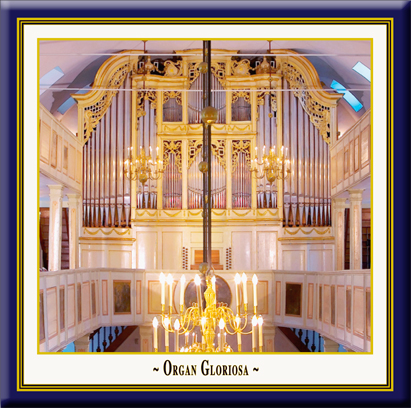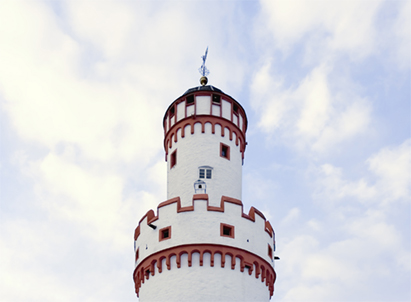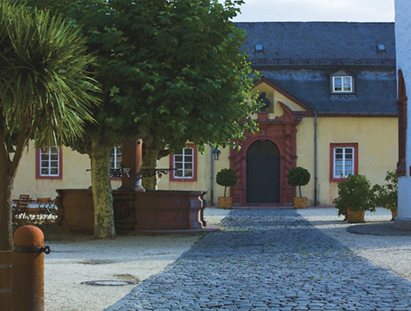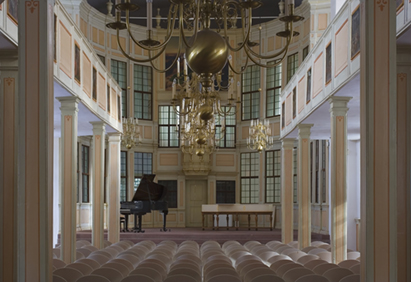
|
Castle Concerts CD Series Ulrike Northoff presents A recording hosted by "Musik im Schloss" Bad Homburg Recorded, produced and created Audio-CD, ca. 56 minutes, DDD
|
|
Organ Gloriosa, a concert in honour of the Prince of Homburg - our first production involving the Great Buergy Organ in the Bad Homburg Castle Church is dedicated to him. During the recordings, the sound of the organ penetrated into the depths of the Landgrave family crypt, thus transforming the famous Prince along with his ancestors and descendants into an illustrious audience for this recital. May their goodwill go with this series of concerts and recording productions. Just imagine - a church full of shadows, a hard pew, gazing at the altar out there in front, waiting for the sound of the organ to come from far away, from heaven ... The popular way of listening to an organ concert. Yet I ask myself - what about the masters of an instrument like this? Composers like Bach and Mendelssohn - what were their feelings? What was the decisive factor that triggered their magnificent and profound compositions?
Have you ever sat at a church organ? Staring at the manuals, in front of you the keys and the stops - and, stretching away behind you, the noble nave and transept of the church. Then, looking upwards, you see the mighty bass pipes that seem to tower over you, reaching up and up before losing themselves in the half-light of the vaulted ceiling... And now, the first hesitant touch of the keyboard, a resonant booming that uplifts the soul - and you immerse yourself in the sound of the organ, which has indeed rightly been christened the "Magic Horn of God". This is the approach we are taking with this presentation of the Buergy Organ. coming to you from the Bad Homburg Castle Church and featuring our virtuoso, Ulrike Northoff. We want to bring home to you the wonderful and powerful tones of this instrument - exactly as it sounded in the days of the old masters, when they sat at the keyboard of an organ and devised these compositions in honour of the Creator. Josef-Stefan Kindler |
|
The Great Buergy Organ of 1787 in Bad Homburg Castle Church dates back to those eventful times at the end of the 18th century. At that time, there lived in the little town of Homburg, seat of the Landgraves, a superb organ maker from Switzerland by the name of Johann Conrad Buergy (1721 - 1792). He received a commission from the Protestant-Lutheran Church Convent to build what was to be his greatest masterpiece. With 38 stops distributed over three manuals and pedals, this organ is a magnificent example of Central German organ building in the style documented as being preferred by Johann Sebastian Bach because of its distinctive sound. The effulgence of the organ takes on something of the Northern German tradition without neglecting the tonic keynotes found in Southern German organ building.
With its many registers, the organ offers a wide variety of wonderfully different sounds, ranging from exquisite solo voices of remarkable colour to a majestic tutti with striking bass tones. It is therefore equally suited to interpreting Baroque or Pre-Baroque works, classical compositions or selected pieces from the Romantic era, or indeed, even modern music. An unusual feature of the organ is its echo chamber: the wind chests and the pipes of this section of the instrument are hidden in the lower part of the organ housing, so that the tones are not directed straight into the church, but diverted though various byways, thus sounding remote and almost echo-like - an effect very popular in Baroque music, which was later continued with the remote consoles of Romantic organs.
The impressive sound is accompanied by opulent visuals: the artistic back-drop of pipes, which fills the entire rear space above the first gallery right up to under the church ceiling, forms a striking counterpart to the choir section facing it, framed by two rows of windows. These bathe the interior of the church in a warm glow of light that was nearly lost in the course of the changing history of the castle. For, with the dwindling influence of the Landgraves, the organ rapidly fell into disrepair. After only 90 years, its use was discontinued and it was later dismantled. All that remained were the housing and the bellows and - for a short time - the tin flue pipes, until these were melted down during the 1st World War. However, 200 years after its commemoration, two lucky coincidences made it possible to restore the organ to its original glory: Johann Conrad Buergy had a journeyman by the name of Johann Georg Foerster, who was to become one of the founders of Foerster & Nicolaus, the world-renowned and respected Hesse firm of organ builders. Buergy's knowledge of the art of organ making has been handed down in this company until today. In the 1980s, the devoted citizens of Bad Homburg who were members of the Board of Trustees of the Bad Homburg Castle Church succeeded in having not just the church building restored to its original splendour, but the Great Buergy Organ of 1789 as well. And what could have been more natural than to entrust this demanding task to Foerster & Nicolaus, who duly completed it in 1989?
Today you can admire the organ in all its glory - as one of the few remaining testimonies to the style of organ building in the classical era. Its distinctive sound and remarkably broad range have been captured fully on this CD for the very first time. |
|
|
|||||||||||||||||||||||||||||||||||||||||||||||||||||||||||||||||||||||||||||||||||||||||||||||||||||||||||||||||||||||||||||||||||||||||||||||||||||||||||||||||||||||||||||||||||||||||||||
|
Reviewers stress her "palpable joy in playing" (Frankfurter Allgemeine Zeitung). She brings a "rare freshness and vibrancy to the organ" (Stuttgarter Nachrichten). In addition to her solo concerts, Ulrike Northoff regularly appears in "Organ Plus" programmes with musicians from the Hesse Radio Orchestra as well as with other soloists from Germany and elsewhere, winning acclaim for her "delicate and adaptable accompaniment" (Frankfurter Rundschau).
|
|
It was thanks to Heinrich von Kleist's drama "The Prince of Homburg" that the former residence of the Landgraves of Hesse-Homburg, a stone's throw away from the gates of Frankfurt, became world-famous. The palace with its wonderful gardens is probably one of the most beautiful baroque estates in Germany. It is therefore no wonder that the Prussian Kings and German Kaisers were very fond of spending the summers between 1866 and 1916 here. And also no doubt because of the relaxation and recreation provided by the town of Bad Homburg vor der Höhe, a spa famous for its medicinal springs. Even the Prince of Wales used to come here in search of amusement, relaxation and "to take the waters" along with the English and Russian aristocracy.
At the courts of Europe, art was extremely multi-faceted. The educated aristocracy was aware of the necessity to support and cultivate the fine arts, and in doing so, created the basis for Europe's ambience. And so it was thanks to arts patron Isaak von Sinclair that the poet genius Friedrich Hölderlin became the court librarian at Homburg Castle during the artistically formative years of his life. It was here that Hölderlin wrote "Patmos", probably his best-known poem. In those days, much that was of little ostensible or commercial value in the fine arts or in literature and music aroused considerable attention and admiration, thus laying the foundations of our cultural life and identity today.
Music that is new, pieces worth listening to and well worth conserving, little treasures from the traditional and the avant-garde - music that is unimaginable anywhere else but in the hotbed of Europe - our "Castle Concerts" series of recordings captures these in their original settings and preserves them for the future. By his endowment to the town church in Bad Homburg, Kaiser Wilhelm II unwittingly did the little church in the palace a favour and helped turn it into one of the most beautiful and intimate concert halls in Europe. The Castle Church fell into disuse and was forgotten, along with its magnificent late-18th century Bürgy organ. The turmoil and modernization fads of the 20th century passed it by, and it remained untouched until a local initiative, the "Bad Homburg Castle Church Trust", stepped in and secured enough patronage to save this architectural gem. True to the original and with a loving attention to detail, both, church and organ were restored to create a truly wonderful concert hall.
Today the Castle Church sparkles with a renewed radiance that is set off perfectly by the superb "Music in the Castle" concerts. View the website of the "Music in the Castle" concerts at www.musik-im-schloss.de |
|
Organ Gloriosa Ulrike Northoff
Johann Sebastian Bach (1685-1750) Georg Muffat (1653-1704) Carl Philipp Emanuel Bach (1714-1788) Christian Heinrich Rinck (1770-1846) Felix Mendelssohn Bartholdy (1809-1847) |
|
The CD Series Publishing culture in its authentic form entails for us capturing and recording for posterity outstanding performances and concerts. The performers, audience, opus and room enter into an intimate dialogue that in its form and expression, its atmosphere, is unique and unrepeatable. It is our aim, the philosophy of our house, to enable the listener to acutely experience every facet of this symbiosis, the intensity of the performance. The results are unparalleled interpretations of musical and literary works, simply - audiophile snapshots of permanent value, recorded in direct 2-Track Stereo digital. In our Edition Authentic Classical Concerts we go in search of this dialogue - to the large constructions and rare pearls of human architecture. For every building has its peculiarities, formed by its historical, acoustic and atmospheric circumstances. But the critical element remains the person, the artist with his intellectual sensibilities. The genesis, the origin, the environment, the musical evolution and education are all factors that develop our tastes and preferences: for example, for a love of large spaces, of classical or modern architecture. It is not without reason that the peoples of other continents and cultures enthuse over the fascination of the European experience... is not "the land of opportunity" or the magic of the orient equally worthy of a visit? Is not the sensitivity of an Italian opera singer or a Bulgarian violinist crucial to the interpretation, the handling of the composition, the work? And finally, the circle is closed with the emotions of the audience and the atmosphere of the performance site. These subjectivities are mirrored in the perception of an atmosphere, a space - creating an individual, personal imagined space within a space - coloring the conception of a piece. Classical music lives! Lives through the interpretation, the tension built up during the performance, and through the combination of work, space, artist and audience. We accept the challenge and record the concerts directly in digital stereo and thus become a part of the performance itself, capturing, in sound and pictures, the impressions, the suspense that we enjoy during a concert - so that we may impart to you as authentic an experience as possible. Flourishing culture in living monuments, enthralling the audience and last but not least also you the listener are the values we endeavor to document in this series. Andreas Otto Grimminger & Josef-Stefan Kindler |






 She has given solo recitals in places such as the Marien-Cathedral in Riga, where she performed on the biggest Romantic organ in the world - the famous Walcker Organ. She has also played several times in Meissen Cathedral, one of the most important historical monuments in Germany. She is a regular guest at celebrated international organ festivals in, for example, the Polish city of Krakow or at Brno in the Czech Republic and Vilnius in Lithuania. Ulrike Northoff has given organ recitals in famous churches in Basel, Copenhagen and St. Petersburg as well as at important concert venues in Germany, including the Solitude Palace outside Stuttgart, the Stiftskirche in Tuebingen and several times at the Hoechster Orgelsommer festival in Frankfurt.
She has given solo recitals in places such as the Marien-Cathedral in Riga, where she performed on the biggest Romantic organ in the world - the famous Walcker Organ. She has also played several times in Meissen Cathedral, one of the most important historical monuments in Germany. She is a regular guest at celebrated international organ festivals in, for example, the Polish city of Krakow or at Brno in the Czech Republic and Vilnius in Lithuania. Ulrike Northoff has given organ recitals in famous churches in Basel, Copenhagen and St. Petersburg as well as at important concert venues in Germany, including the Solitude Palace outside Stuttgart, the Stiftskirche in Tuebingen and several times at the Hoechster Orgelsommer festival in Frankfurt. After several years as full-time cantor and music director in Bad Homburg, in 2001 Ulrike Northoff became the artistic director of the concert series "Musik im Schloss" ("Music in the Castle"). Since 2006, as part of this series, she started the international Bad Homburg festival, "Orgelsommer im Schloss" ("Summer with the Organ in the Castle").
After several years as full-time cantor and music director in Bad Homburg, in 2001 Ulrike Northoff became the artistic director of the concert series "Musik im Schloss" ("Music in the Castle"). Since 2006, as part of this series, she started the international Bad Homburg festival, "Orgelsommer im Schloss" ("Summer with the Organ in the Castle").


